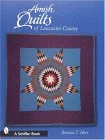America's Quilting History
Amish Quilts: Beauty in Simplicity

The word "Amish" brings a picture to mind - one of horses and buggies, barn raising, living off the land without modern conveniences, and of quilts. In truth the Amish came late to quilting. Long after their neighbors were piecing quilts, the Amish still used the old German featherbeds and coverlets. There was a good reason for this. Amish communities were formed so that the members could remain apart from the temptations of the modern world. But what is considered 'modern' changes over the years. The Amish gradually made changes as well, but often a few decades later.
Very few quilts are known to have been made by the Amish before the 1870s. Then over 15 years quilting became quite common. As we follow the evolution of their quilt making we find that the Amish have chosen to use the most conservative styles. The first Amish quilts were made in one solid color, of brown, blue, rust or black. Often worsted wools were used, and though the fabric was plain, the quilting done to hold the layers together was intricate and decorative and included swirling feathers, curves and grids. Gradually some basic piecing was added. For example a quilt which may have had a large diamond in the middle of a dark fabric with only wide border around it evolved to include pumpkin, olive green and an occasional dark red. These new colors were still deep and solid.
As the general population moved on to elaborate Crazy quilts the Amish adopted some of the more basic of the block patterns. Nine patch, Around the World, and Sunshine and Shadow were popular. Only solid colored fabric was used but with more varied colors. Amish quilts were made of wool or cotton, as popular silks were considered too worldly.
Many Amish quilters used black as an integral part of the quilt. In the hands of these creative women this recipe of simplicity brought about amazing results. The play of the black against the saturated hues created a vibrant and distinctive quilt. Quilts may have been pieced using a treadle sewing machine but the beautiful quilting was always done by hand. Solid fabrics showcased the women's hand quilting skills.

Although most piecing was done at home when the top was ready to be quilted it was often an occasion for women to gather around the quilting frame. Living as part of the community is central to Amish life and quilting fits into this pattern. It was natural for quilting to become another traditional task, one of many done in groups. This sense of community and the importance of complying with community standards had a great influence on Amish quilting. Changes in how quilts were made occurred slowly and only with community approval. Interestingly, this also brought about a good deal of variety from community to community as each community had it's own, often unwritten guidelines as to how things should be done. Pink or white fabric may have been considered unacceptable in a more conservative area, while drab browns may have been thought dull and old-fashioned in a more liberal one. A quilt made in one community might be put away or sold when the family moved to another one.
In the early twentieth century new brighter colors became available and women began to adapt traditional patterns to create more complex designs. During the World War II natural fiber was hard to come by and even the Amish had to turn to the synthetics available at the that time. As most of the nation turned away from quilting, considering it old-fashioned and a waste of time, the Amish continued the tradition.
By the 1940s the Amish began to add more pastels and in rare cases printed fabric. Many communities allowed more freedom in design and even appliqué began to appear. Hand quilting was no longer as detailed as it had been in earlier times. The unique art of Amish quilting might have declined to utilitarian craft if it were not for the discovery of Amish quilts by the general population.
With the approach of the bicentennial in 1976 Americans became very interested in their past and in the process discovered the unique art of Amish quilting. Amish quilts became a popular item and Amish women began to produce quilts to be sold.

Quilts continue to be made by the Amish for family use. Women make quilts for weddings, babies, friendship and as fund-raisers. Because the women are often busy in the garden and helping with the farming in the milder months, most of the quilt making has always been done in the winter. Young mothers may find little time for quilting but many grandmothers produce a number of quilts. Although more quilts are being made for sale, quilting is still an important part of family and community life.
Amish quilts continue to be a source of inspiration to quilters. Modern quit artists are using black with solid colors and discovering the beauty in such basic designs that represent a more basic life. Amish women live this simple life and their quilt designs are a result of a belief that art is not a separate thing but that beauty is a part of function.
© 2001 Judy Anne Johnson Breneman (Do not reproduce any material from this site without permission.)References:
"Clues in the Calico", by Barbara Brackman
"Amish Quilts", by Eve Wheatcroft Granick
"Quilts a Living Tradition" by Robert Shaw
Be sure to visit the site, "Amish Quilts From Lancaster County", for a fantastic Internet exhibit of Amish quilts.
The above collection is now at the Lancaster Quilt and Textile Museum



